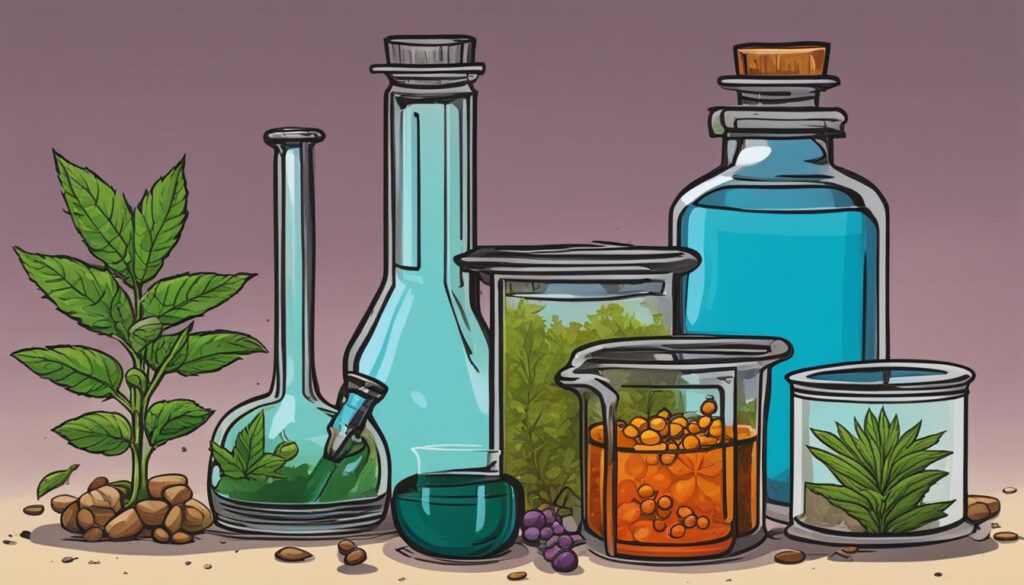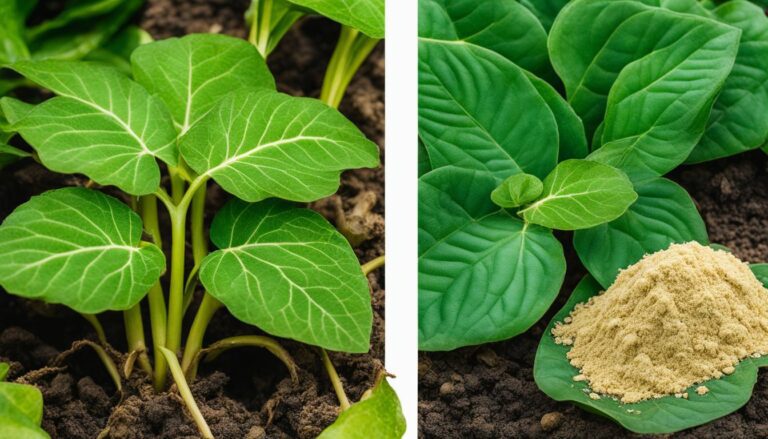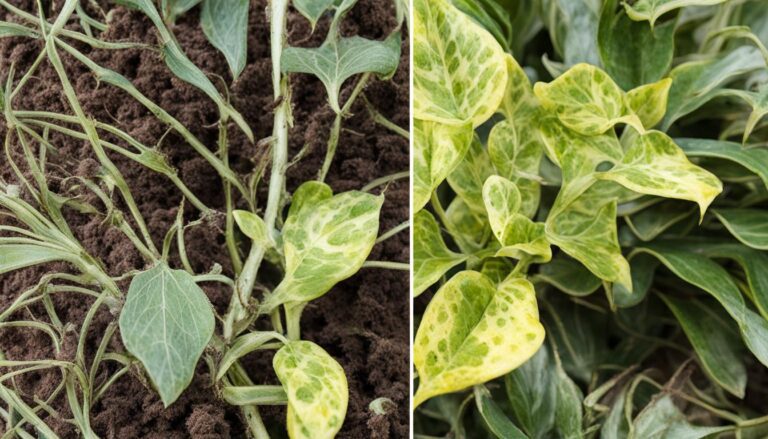
Medicinal plants have long been used to create natural remedies for various health conditions.
In this comprehensive guide, I will explore the process of preparing remedies from medicinal plants, allowing you to harness the power of nature for your own healing.
Key Takeaways:
- Medicinal plants offer a natural and plant-based approach to healing.
- Preparing remedies from medicinal plants involves a series of steps, including collection, authentication, and extraction.
- Various extraction techniques, such as maceration and infusion, are used to obtain bioactive compounds.
- Solvent selection plays a crucial role in the extraction process.
- Herbal supplements are an alternative form of natural medicine that can support overall health and well-being.
The Importance of Herbal Medicine
Herbal medicine, also known as botanical medicine or phytomedicine, is gaining popularity as people seek natural alternatives and holistic remedies for their health concerns. This centuries-old practice harnesses the healing properties of medicinal herbs, making it a valuable avenue for natural healing and wellness.
Medicinal herbs contain a wide array of bioactive compounds that contribute to their medicinal properties. These compounds, found in various parts of the plant such as leaves, roots, flowers, or bark, hold the potential to support the body’s innate healing mechanisms and promote overall well-being.
By embracing herbal medicine, individuals can experience the benefits of natural healing and preventive care.
Herbal medicine aligns with the principles of holistic health, considering the whole person rather than just specific symptoms or diseases. It emphasizes the importance of treating the root cause of an ailment rather than merely alleviating symptoms.
This approach recognizes that physical health is interconnected with mental, emotional, and spiritual well-being, encouraging a comprehensive and integrative approach to healing.
As interest in natural healing and herbal remedies continues to grow, herbal medicine offers a promising path for those seeking alternative solutions to their health concerns.
By incorporating medicinal herbs into their wellness routines, individuals can tap into the power of nature and embrace a holistic approach to their well-being.
The Importance of Herbal Medicine
| Benefits of Herbal Medicine | Considerations of Herbal Medicine |
|---|---|
|
|
Understanding the Preparation Process
In order to harness the medicinal properties of plants, it is important to understand the preparation process involved. This section will delve into the various methods and techniques used to extract bioactive compounds from medicinal plants.
Preparation Methods
Preparing remedies from medicinal plants requires careful attention to detail, starting with the collection and authentication of plant materials.
Once the plant material is obtained, it is crucial to properly dry and grind it before beginning the extraction process. Drying the plant material helps preserve its medicinal properties, while grinding increases the surface area for extraction.
The extraction process is where the bioactive compounds are obtained from the plant material. Different extraction techniques, such as maceration, infusion, decoction, and percolation, are employed to extract these compounds. Each technique has its own advantages and is chosen based on the specific plant material and desired outcome.
Extraction Techniques
Maceration is a simple technique where the plant material is soaked in a solvent, allowing the bioactive compounds to diffuse into it. Infusion involves using hot water to extract the compounds, while decoction requires boiling the plant material to extract the desired compounds.
Percolation is a more complex process that involves slowly passing a solvent through the plant material, ensuring efficient extraction. These extraction techniques help capture the bioactive compounds responsible for the medicinal properties of the plants.
Phytochemical Screening
Phytochemical screening is an important step in the preparation process, ensuring the quality and potency of the final product. It involves the analysis and identification of different chemical compounds present in the plant material.
Techniques such as chromatography and spectrophotometry are used to separate and identify these compounds, providing valuable insights into the chemical composition of the plant material.
By understanding these preparation methods, extraction techniques, and phytochemical screening processes, we can ensure the effective utilization of medicinal plants for natural remedies.
| Extraction Technique | Description |
|---|---|
| Maceration | Soaking plant material in a solvent to allow the bioactive compounds to diffuse. |
| Infusion | Using hot water to extract compounds from the plant material. |
| Decoction | Boiling the plant material to extract desired compounds. |
| Percolation | Slowly passing a solvent through the plant material for efficient extraction. |
Selecting the right solvent
When preparing remedies from medicinal plants, selecting the right solvent is crucial for extracting the desired bioactive compounds. The choice of solvent depends on factors such as the nature of the compounds and the intended use of the final product.
Polar solvents like water and alcohols are often used when extracting water-soluble compounds, while nonpolar solvents such as n-hexane and chloroform are preferred for extracting lipophilic compounds.
Each solvent has its advantages and limitations. Water, being a universal solvent, is commonly used for extraction due to its accessibility and ability to extract a wide range of compounds.
Alcohols like ethanol and methanol are also popular solvents due to their ability to extract both polar and nonpolar compounds. On the other hand, nonpolar solvents are effective in extracting compounds with high lipid content, but they may not be suitable for extracting hydrophilic compounds.
The solvent selection process should take into consideration solubility, polarity, and compatibility with the plant material.
It is essential to choose a solvent that can effectively extract the desired bioactive compounds while minimizing the extraction of unwanted compounds. Experimentation and optimization are often necessary to determine the most suitable solvent for a specific plant material and desired outcome.

Solvent Selection for Medicinal Plant Extraction
| Solvent Type | Examples | Characteristics | Commonly Extracted Compounds |
|---|---|---|---|
| Polar Solvents | Water, Ethanol, Methanol | Highly soluble in water, extract both polar and nonpolar compounds | Phenolic compounds, Flavonoids, Glycosides |
| Nonpolar Solvents | n-Hexane, Chloroform | Low solubility in water, extract lipophilic compounds | Essential oils, Terpenes, Alkaloids |
Common Extraction Methods
In the process of preparing remedies from medicinal plants, several extraction methods are commonly used to extract bioactive compounds. Each method has its advantages and is chosen based on the plant material and desired outcome.
Maceration
Maceration is a simple and widely used extraction method. In this method, the plant material is soaked in a solvent, such as alcohol or oil, for a specific period. This allows the solvent to dissolve the bioactive compounds present in the plant material.
The resulting solution, known as a macerate, is then filtered to remove any solid particles. Maceration is especially effective for extracting compounds from delicate plant materials and is commonly used in herbal preparations like tinctures and infused oils.
Infusion
Infusion involves using hot water to extract the bioactive compounds from the plant material. This method is particularly suitable for extracting water-soluble compounds like essential oils and flavonoids.
The plant material is added to boiling water and left to steep for a certain period, allowing the water to absorb the beneficial compounds. The resulting infusion can be consumed as a tea or used as a base for other preparations.
Decoction
Decoction is the process of boiling the plant material in water to extract the medicinal compounds. This method is commonly used for extracting compounds from harder parts of plants, such as roots, barks, and stems.
The plant material is simmered in water for a specific duration, allowing the water to extract the bioactive compounds through heat. Decoctions are often used in traditional herbal remedies and are known for their concentrated and potent effects.
Percolation
Percolation is a more advanced extraction method that involves the slow passage of a solvent through the plant material. The plant material is packed into a column or chamber, and the solvent is continuously poured or pumped through the material.
As the solvent passes through the plant material, it extracts the bioactive compounds. Percolation is a precise and efficient method that allows for the extraction of a wide range of compounds. It is commonly used in the pharmaceutical industry and for the production of standardized herbal extracts.
Soxhlet Extraction
Soxhlet extraction is a method that combines aspects of both maceration and percolation. This extraction technique is particularly useful for extracting compounds that are not easily soluble in solvents.
The plant material is placed in a specialized apparatus called a Soxhlet extractor, which contains a solvent. The solvent is heated and evaporates, condenses, and drips back onto the plant material, allowing for repeated extraction cycles. This process ensures a thorough extraction of the desired compounds.
Each extraction method offers unique advantages and is chosen based on the properties of the plant material and the specific compounds being targeted. By understanding the different extraction techniques, you can effectively harness the healing power of medicinal plants and create your own natural remedies.
Fractionation and Purification
Once the bioactive compounds are extracted from medicinal plants, they often undergo fractionation and purification processes to isolate specific compounds of interest. Fractionation is the process of separating the mixture into different fractions based on their properties. This step allows researchers to focus on the compounds with the desired therapeutic effects.
To achieve separation, various fractionation methods are employed, depending on the characteristics of the compounds and the desired outcome.
Popular fractionation methods include liquid-liquid extraction, where solvents of different polarities are used to extract specific compounds, and crystallization, which involves cooling the mixture to obtain pure crystals of the desired compound.
Purification techniques are then utilized to further refine the compounds and remove any impurities. Chromatography is one of the most commonly used purification techniques in herbal medicine.
It involves the separation of compounds based on their affinity for a stationary phase and a mobile phase. Different types of chromatography, such as column chromatography, thin-layer chromatography (TLC), and high-performance liquid chromatography (HPLC), are employed to achieve efficient purification.
Common Fractionation and Purification Techniques
| Fractionation Methods | Purification Techniques |
|---|---|
| Liquid-liquid extraction | Column chromatography |
| Crystallization | Thin-layer chromatography (TLC) |
| Distillation | High-performance liquid chromatography (HPLC) |
| Partition chromatography | Preparative liquid chromatography |
These fractionation and purification techniques help researchers isolate and purify the compounds of interest, ensuring the production of high-quality plant-based medicines.
By obtaining pure compounds, researchers can conduct further studies to understand the compounds’ mechanisms of action, optimal dosage, and potential interactions.
Characterization of Compounds
Once the compounds extracted from medicinal plants are isolated, it is essential to employ identification techniques to study their properties. Mass spectroscopy, infrared spectroscopy, and nuclear magnetic resonance spectroscopy are widely used for compound characterization and analysis.
Mass spectroscopy is a technique that measures the mass-to-charge ratio of ions, providing valuable information about the molecular weight and composition of the compounds. It helps identify the presence of specific elements and functional groups within the compounds.
Infrared spectroscopy involves measuring the absorption of infrared radiation by the compounds. This technique provides insight into the molecular structure and functional groups present, allowing for the identification of different compounds based on their unique spectral patterns.
Nuclear magnetic resonance spectroscopy utilizes the magnetic properties of atomic nuclei to determine the structure and composition of compounds. It provides valuable information about the connectivity of atoms within the molecule and can help identify structural isomers and stereochemistry.
| Technique | Key Features | Applications |
|---|---|---|
| Mass Spectroscopy | – Measures mass-to-charge ratio of ions – Identifies molecular weight and composition | – Compound identification – Quantitative analysis – Proteomics and metabolomics |
| Infrared Spectroscopy | – Measures absorption of infrared radiation – Determines molecular structure and functional groups | – Compound identification – Quality control – Environmental analysis |
| Nuclear Magnetic Resonance Spectroscopy | – Utilizes magnetic properties of atomic nuclei – Determines compound structure and connectivity | – Compound identification – Structural elucidation – Drug discovery |
The combination of these identification techniques allows for a comprehensive analysis of the compounds extracted from medicinal plants. By understanding the structure, composition, and activity of these compounds, researchers can determine their suitability for medicinal purposes and further explore their potential health benefits.

The role of herbal supplements
In addition to preparing remedies from medicinal plants at home, herbal supplements are widely available as an alternative form of natural medicine.
Herbal supplements, classified as dietary supplements, are made from plant materials and are used to support overall health and well-being. They offer a convenient and accessible way to incorporate the benefits of medicinal plants into your daily routine.
Herbal supplements are popular for their potential to provide various health benefits. They are often used to address specific health concerns or as preventive measures.
Some common examples of herbal supplements include Echinacea for immune support, St. John’s wort for mild-to-moderate depression, Ginkgo for memory enhancement, Garlic for cardiovascular health, Saw palmetto for prostate health, and Ginseng for overall well-being.
Benefits of herbal supplements:
- Natural and plant-based: Herbal supplements are derived from natural sources, making them a popular choice for those seeking natural remedies.
- Diverse options: There is a wide range of herbal supplements available, each offering unique benefits and targeting specific health concerns.
- Support for overall well-being: Herbal supplements can be used to support and promote overall health and wellness.
- Convenience: Herbal supplements are easy to incorporate into your daily routine, as they are available in various forms such as capsules, tablets, liquids, and teas.
It’s important to note that herbal supplements should be used under the guidance of a trained healthcare provider. They can provide valuable insight into dosage, potential interactions with medications, and ensure the supplements are safe and suitable for your specific needs.
It’s essential to be aware of any potential allergies or sensitivities to specific herbs to avoid any adverse reactions.
By incorporating herbal supplements into your wellness routine, you can tap into the power of medicinal plants in a convenient and accessible way.
However, I always recommend to consult with a healthcare professional to ensure the safe and effective use of herbal supplements as part of your holistic approach to health and well-being.
Commonly used herbal supplements
When it comes to herbal supplements, there are several popular options that people turn to for various health conditions. These supplements, derived from medicinal plants, offer natural alternatives to conventional medications. Let’s explore some of the commonly used herbal supplements and their benefits:
Echinacea
Echinacea is a popular herbal supplement known for its immune-supportive properties. It has been traditionally used to prevent and treat colds and flu. Echinacea is available in various forms, including capsules, tinctures, and teas.
St. John’s wort
St. John’s wort is often used as a natural remedy for mild-to-moderate depression. It is believed to help improve mood and alleviate symptoms of anxiety. St. John’s wort is available in capsule form and can interact with certain medications, so it’s important to consult with a healthcare provider before use.
Ginkgo
Ginkgo, derived from the Ginkgo biloba tree, is commonly used for memory enhancement and cognitive support. It is believed to improve blood circulation and protect against age-related cognitive decline. Ginkgo is available in capsule form and is often used as a supplement for overall brain health.
Garlic
Garlic is well-known for its culinary uses, but it is also used as an herbal supplement for its cardiovascular benefits. Garlic is believed to help lower blood pressure and cholesterol levels. It is available in various forms, including capsules and oils.
Saw palmetto
Saw palmetto is a popular herbal supplement for maintaining prostate health. It is often used to alleviate symptoms of an enlarged prostate, such as frequent urination. Saw palmetto is available in capsule form and is commonly used as a natural alternative to prescription medications.
Ginseng
Ginseng is a widely used herbal supplement that is believed to promote overall well-being and vitality. It is often used to increase energy levels, improve mental focus, and boost the immune system. Ginseng is available in various forms, including capsules, extracts, and teas.
These commonly used herbal supplements offer natural alternatives for addressing various health concerns. However, it is important to remember that herbal supplements may interact with medications or have side effects. It is always advisable to consult with a healthcare provider before starting any new supplement regimen to ensure safety and effectiveness.
Benefits and Considerations of Herbal Medicine
Herbal medicine offers a holistic approach to healing, embracing the power of natural remedies. By harnessing the medicinal properties of plants, individuals can enhance their overall well-being and explore potential alternatives to conventional medications.
It is essential to consider various factors when incorporating herbal medicine into your healthcare routine.
One of the key benefits of herbal medicine is its emphasis on holistic healing. Rather than focusing solely on treating symptoms, herbal remedies aim to address the underlying causes of health issues.
This approach takes into account the interconnectedness of the body, mind, and spirit, promoting overall wellness.
While herbal medicine can be beneficial, it is crucial to be aware of potential interactions with prescription medications and existing medical conditions. Some herbal remedies may interact with certain medications, impacting their effectiveness or causing adverse effects.
It is essential to consult with a healthcare provider before incorporating herbal remedies, especially if you are taking medications or have pre-existing health conditions.
Additionally, safety precautions should be observed when using herbal medicine. It is important to source high-quality herbs from reputable suppliers to ensure their potency and purity.
Adhering to recommended dosages and guidelines is crucial to prevent any adverse effects. If you have any known allergies or sensitivities to specific herbs, it is important to exercise caution and consult with a healthcare provider.
Benefits and Considerations of Herbal Medicine: Summary
- Herbal medicine offers a holistic approach to healing, promoting overall well-being.
- Consider potential interactions with prescription medications and existing medical conditions.
- Observe safety precautions, source high-quality herbs, and adhere to recommended dosages.
| Benefits | Considerations |
|---|---|
| Embraces holistic healing | Potential interactions with medications |
| Natural remedies for overall well-being | Safety precautions and high-quality sourcing |
| Potential alternatives to conventional medications | Adherence to recommended dosages |

The Future of Herbal Medicine
As advancements in clinical research continue to unfold, the future of herbal medicine looks promising. Botanical medicine, once considered alternative, is now gaining recognition and acceptance as a natural healing option. The World Health Organization acknowledges the value of herbal medicine, and many countries have integrated it into their healthcare systems.
With a growing interest in holistic healing and a desire for natural remedies, herbal medicine offers a range of possibilities. The potential benefits extend beyond symptom relief and address the root causes of health issues. By tapping into the power of medicinal plants, individuals can access a wealth of natural healing options.
The integration of herbal medicine into mainstream healthcare is likely to grow as research progresses. Advancements in clinical studies provide deeper insights into the efficacy and safety of botanical treatments.
This ongoing exploration will enhance our understanding of the therapeutic properties of medicinal plants and their potential applications in various health conditions.
As we look to the future, herbal medicine represents an opportunity for individuals to take an active role in their own well-being. By embracing natural healing options and incorporating botanical medicine into their wellness practices, people can experience the benefits of a holistic approach to health.
Benefits of Botanical Medicine
| Benefits | Description |
|---|---|
| Natural Healing | Herbal medicine harnesses the healing power of nature, providing a holistic approach to wellness. |
| Individualized Treatment | Herbal remedies can be tailored to a person’s unique needs, addressing specific health concerns. |
| Preventive Care | Herbal medicine offers preventive benefits, promoting overall health and well-being. |
| Reduced Side Effects | Compared to conventional medications, herbal remedies often have fewer side effects. |
As the field of herbal medicine continues to evolve, it is essential to approach its use with knowledge and caution. Consulting a healthcare provider who specializes in botanical medicine is crucial to ensure the safe and effective use of herbal remedies. Together, researchers, practitioners, and individuals can shape the future of herbal medicine, opening up new possibilities for natural healing and well-being.
Preparing herbal remedies from medicinal plants allows me to harness the power of nature for natural healing. By understanding the extraction methods, solvent selection, and characterization techniques, I can create my own remedies at home using plant-based medicine. It’s important to note that herbal medicine should always be used in conjunction with professional advice to ensure safe and effective use.
Embracing the benefits of herbal medicine offers a holistic approach to healing. The use of natural remedies can enhance overall health and well-being, providing an alternative to conventional medications.
However, it’s crucial to consider potential interactions with prescription drugs and existing medical conditions, as well as any allergies or sensitivities to specific herbs.
The future of herbal medicine looks promising, with advances in clinical research and growing interest in holistic healing. As more research is conducted and awareness grows, herbal medicine is likely to become an integral part of healthcare and wellness practices.
With the knowledge and understanding of preparing herbal remedies, I can tap into the healing power of medicinal plants and embrace the natural healing options they provide.
FAQ
How do I prepare remedies from medicinal plants?
To prepare remedies from medicinal plants, you need to follow several key steps including proper collection, authentication, drying, and grinding of plant materials. The extraction process is crucial for obtaining the bioactive compounds responsible for the plant’s medicinal properties. Various extraction techniques such as maceration, infusion, decoction, and percolation are used to extract these compounds. Phytochemical screening and identification techniques are employed to ensure the quality and potency of the final product.
What is the importance of herbal medicine?
Herbal medicine, also known as botanical medicine or phytomedicine, offers natural healing and holistic approaches to wellness. It provides potential alternatives to conventional medications and can be used to support overall health and well-being. However, it’s important to consider potential interactions with prescription medications and existing medical conditions. Herbal remedies should be used under the guidance of a healthcare provider to ensure safety and effectiveness.
How can I understand the preparation process of medicinal plants?
Understanding the preparation process of medicinal plants involves learning about extraction techniques, bioactive compounds, and phytochemical screening. It is important to properly collect, authenticate, dry, and grind plant materials to ensure the quality of the final product. Extraction techniques such as maceration, infusion, decoction, and percolation are employed to extract the bioactive compounds responsible for the plant’s medicinal properties. Phytochemical screening and identification techniques are used to ensure the quality and potency of the final product.
How do I select the right solvent for extracting medicinal plants?
The choice of solvent plays a vital role in the extraction of medicinal plants. Solvents can range from polar solvents like water and alcohols to nonpolar solvents like n-hexane and chloroform. The selection of solvent depends on the nature of the bioactive compounds being extracted, as factors like solubility, polarity, and intended use of the final product need to be considered.
What are the common extraction methods used for medicinal plants?
Common extraction methods for medicinal plants include maceration, infusion, decoction, percolation, and Soxhlet extraction. Maceration involves soaking the plant material in a solvent, while infusion uses hot water for extraction. Decoction involves boiling the plant material, and percolation slowly passes a solvent through the plant material. Soxhlet extraction employs repeated cycles of extraction and evaporation.
What is the process of fractionation and purification?
After extraction, bioactive compounds are often subjected to fractionation and purification processes to isolate specific compounds of interest. Fractionation involves separating the mixture into different fractions based on their properties. Chromatographic techniques such as paper chromatography, thin-layer chromatography, gas chromatography, and high-performance liquid chromatography are commonly used for fractionation and purification.
How are compounds characterized in herbal medicine?
Compounds in herbal medicine are characterized using identification techniques such as mass spectroscopy, infrared spectroscopy, ultraviolet spectroscopy, and nuclear magnetic resonance spectroscopy. These techniques provide valuable information about the structure, composition, and activity of the compounds, ensuring their suitability for medicinal purposes.
What is the role of herbal supplements?
Herbal supplements are a form of natural medicine and are widely available to support overall health and well-being. They are made from plant materials and are classified as dietary supplements. However, it’s important to use herbal supplements under the guidance of a trained healthcare provider to ensure safety and effectiveness.
What are some commonly used herbal supplements?
Some commonly used herbal supplements include Echinacea for immune support, St. John’s wort for mild-to-moderate depression, Ginkgo for memory enhancement, Garlic for cardiovascular benefits, Saw palmetto for prostate health, and Ginseng for overall well-being. These supplements are available in various forms and can be used as part of a holistic approach to wellness.
What are the benefits and considerations of herbal medicine?
Herbal medicine offers a range of benefits, including natural healing, holistic approaches to wellness, and potential alternatives to conventional medications. However, it’s crucial to consider potential interactions with prescription medications and existing medical conditions. Herbal remedies should be used under the guidance of a healthcare provider to ensure safety and effectiveness. It’s also important to be aware of any potential allergies or sensitivities to specific herbs.
What does the future hold for herbal medicine?
With advancements in clinical research and a growing interest in holistic healing, herbal medicine is gaining popularity as a natural healing option. The World Health Organization recognizes the value of herbal medicine, and many countries have integrated it into their healthcare systems. As more research is conducted and awareness grows, herbal medicine is likely to become an integral part of healthcare and wellness practices.







One Comment
Comments are closed.